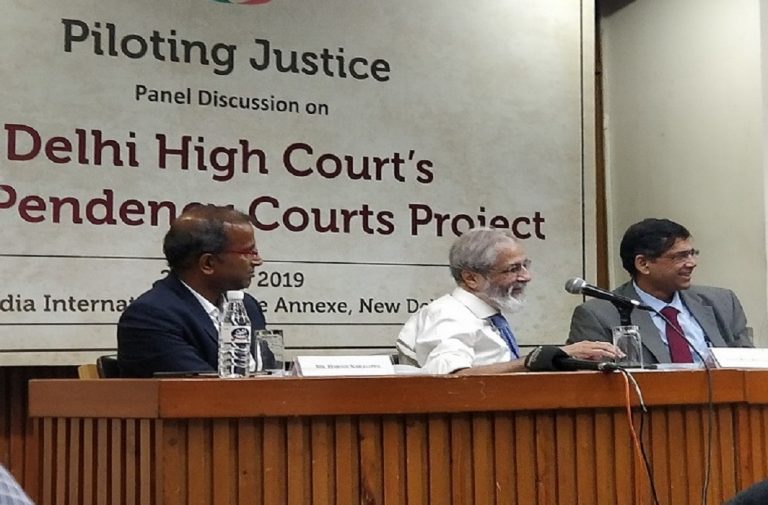
To deliberate on the findings of the Delhi High Courts Zero Pendency Courts Project, DAKSH Bengaluru organised a panel discussion on July 29 2019, at the India International Centre, New Delhi. The discussion witnessed participation by Justice Madan B Lokur and Arvind Datar, Senior Advocate, Madras High Court.
The panel discussed the findings of the ‘Zero Pendency Courts Project Report’ which was released by the High Court on May 3, 2019. The pilot project, a first-of-its-kind in the history of the Indian judiciary, aimed at understanding the functioning of courts when they were not burdened with arrears or backlog, and recommended ideal timelines for disposal of different types of cases. Some of the key findings from the report are as follows:
- Sessions pilot judges dealing with murder cases took on an average approx. 16 hours to dispose sessions cases within 6.5 months while Fast Track pilot court dealing with rape case took on an average 4.4 hours to dispose sessions cases within 90 days. 2) Final order/judgment was the main stage where majority of pilot courts spent the most amount of minutes per hearing. 3) Amongst criminal cases most number of hearings related to the Prosecution Evidence stage. In civil cases misc. cases/purpose which comprised of issuing summons, filing of Written Statement etc. occupied the highest percentage of hearings in a case. 4) Absence of witnesses, frequent adjournments sought by advocates/parties, delay in summons/notices and summoning outstation parties were seen as the major causes for delay in pilot courts. 5) Delhi subordinate courts need additional 43 judges of certain cadre to dispose all pending cases in one year.
The data collected from it will be helpful in shaping policy decisions on the following aspects:
1) Prescribing timelines for various stages of a case; 2) Identifying benchmarks for disposing various types of cases and ultimately codifying them in Case Flow Management Rules for cases; 3) Providing a concrete definition for concepts such as ‘backlog’ and ‘arrears’; 4) Reimagining norms for ‘units system’, which is a metric used to assess the performance of judges; 5) Arriving at an optimal judge strength for subordinate courts.
The event witnessed an engaging discussion on Delhi High Court’s pilot project as well as innovative means of addressing judicial delays through meaningful reforms.
Justice Lokur made the following salient points:
- Any increase in judge strength must take into account the corresponding increase required in support staff. This becomes especially difficult given the low GDP allocation towards the judiciary. Only 4 countries spend lesser than India on the judiciary.
- The average disposal time for cases gets badly skewed because some cases tend to drag for years. It will be worthwhile to do a study to identify what categories those cases fall into.
- To curb adjournments, judges must show decisiveness. But the unfortunate result of that decisiveness is strikes.
- Coming to the definition of pendency, it is generally defined as a case filed but not disposed of. That is an unrealistic definition because a case filed five minutes ago would also be treated as a pending case. And the number of pending cases would just go on increasing. We must arrive at a realistic definition. In my view, a case pending for more than one year should be considered an arrear. I am going on the basis of a study conducted by the National Judicial Academy which found that a civil suit can be completed within one year if the trial is conducted as per the Civil Procedure Code.
- We need to look at technology very seriously to assist in the court management system. We have many technological tools at our disposal but they are not being utilised properly.
Senior advocate Arvind P Datar shared from his experience of practising in various courts and gave the following suggestions:
- We must also look at how the productivity of a judge can be increased. Perhaps outsourcing of calling work, which takes up the bulk of a judge’s time in a day, is one solution.
- To eliminate wastage of judicial time, the timelines prescribed under the CPC must be strictly adhered to. Costs must be implemented strictly in case of adjournments.
- Judicial impact assessment must be considered before framing new laws. Nobody had expected that an avalanche of cases will hit the courts following the introduction of section 138 in the Negotiable Instruments Act.
- Judges should not be burdened with non-judicial responsibilities like forming committees related to administrative and secretarial work.
—India Legal Bureau

